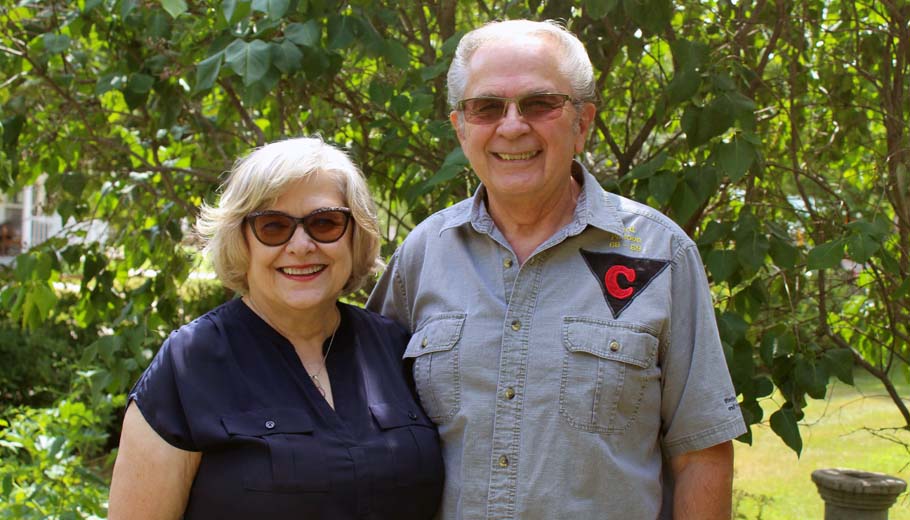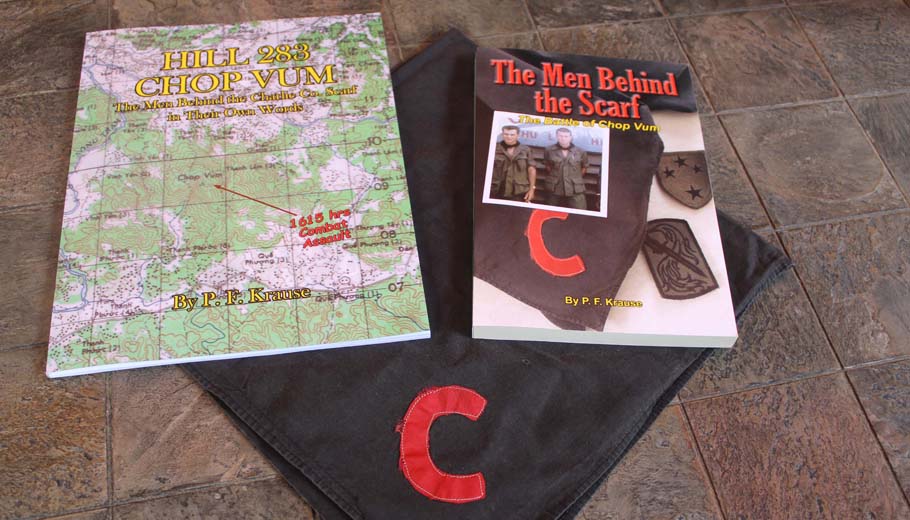Novel tells veterans’ stories
By Angie Landsverk
Peggy Krause was at a reunion with her husband Philip the first time she heard about the Vietnam War battle of Chop Vum.
Years later, she has published a fictional novel about that 1969 battle, as well as a companion book about the real stories of those Charlie Company veterans.
“I’m not a writer who looked for a story,” Peggy said. “The story found me, and I had to tell it.”
The title of her novel is “The Men Behind the Scarf: The Battle of Chop Vum.”
The companion book is “Hill 283, Chop Vum: The Men Behind the Charlie Co. Scarf in Their Own Words.”
Both were published this past spring by New Forums Press Inc.
Peggy’s husband was 19 when he was drafted into the Vietnam War.
He was in Vietnam from November 1968 until the following spring when he was wounded.
Philip was wounded in May 1969, two months after the battle of Chop Vum.
The battle of Chop Vum began on March 3 and ended on March 10.
Charlie Company was sent to join Bravo Company in relieving pressure on Alpha Company.
“They didn’t know the place was called Chop Vum when they were there,” Peggy said. “They were just dropped in.”
A total of 104 men from Charlie were sent to help the other companies and were up against thousands, she said.
Many of them were killed or wounded.
“Even at the end, when they got out, they were so vulnerable,” Peggy said.
The process
Her novel begins with Charlie Company’s commander preparing to tell his platoon leaders about their assignment.
It ends several days with those who remained leaving by helicopter in waves.
Peggy worked on the novel for years after learning about the battle.
“I had no idea it was that big of a battle because he never talked about it,” she said of her husband.
It was in 2002 that Philip first learned of the Charlie Company reunions.
That was when one of his buddies called him and explained that the reunions had begun about two or three years prior, Peggy said.
Each year, they would try to find more who had been part of Charlie Company.
Peggy was at one of the reunions with Philip when she saw some men looking at pictures and remembering the battle.
A couple years later, she brought a video camera to the reunion.
“I would hear people from the different platoons telling their stories,” she said. “I started asking guys if I could interview and tape them. I would do two or three each year.”
Philip and Peggy’s daughter, Kristin Hamilton, joined them a number of years and helped with the interviews.
“It almost became an obsession,” Peggy said. “I would come back and transcribe it. I would be just as shocked.”
Initially, she planned to make a scrapbook.
That ended up becoming the companion piece.
As she began reading more and more books about the Vietnam War, she did not find one that had the emotions she felt when she heard the stories at the reunions.
Her mission
Peggy’s goal was to help people see the emotional side of war.
“I would say most if not all of the men broke down when I interviewed them,” she said.
She told all of them that if it was too hard to talk about it, they could stop.
But they all went on no matter what, she said.
“They all wanted the story told,” Peggy said.
Many often said to her, “I’ve been trying to forget this for the last 40-some years,” she said.
Philip and Peggy will be married 49 years this November.
Peggy said he answered her questions freely, but she did not know what to ask.
Philip said the reunions have helped them talk about what they saw in the war.
“I still don’t talk about it. I don’t care to. It’s rough,” he said.
The characters in Peggy’s novel are based on some who were in Charlie Company.
One of them told her he bought the book for his children because it “describes what it was like there more than I could tell them what it was like there.”
Peggy said she made it fiction, because their stories did not always match.
She spent about a year doing research before she began writing.
That involved reading maps and journals.
She piled the resources on her grandfather’s drop-leaf table in their Waupaca home and spread the materials out as she worked.
Peggy worked on the novel sporadically.
“I learned that I had to have enough time to be in it,” she said. “I couldn’t do it for just one hour.”
The publisher of her books became part of Charlie Company in July 1969.
She met him at one of the reunions and sent him the manuscript when it was done.
It was his idea to turn the scrapbook into a companion book.
Both books are available through the publisher or on Amazon.
Peggy is a retired registered nurse.
She worked in nursing for 40 years, including 22 years at the Wisconsin Veterans Home at King.
Peggy learned a lot working on the book and described what it felt like to complete it.
“It was very exciting and I felt pretty nervous about it,” she said. “I think so much of these guys that I hope I’m doing justice.”
Phil said, “If she had never done it, the story would have never been told. It’s a part of history that a lot of people don’t know about.”
Peggy said everyone was patient and generous as they answered her questions.
“I’m so passionate about the story,” she said. “I wanted to get the story out there.”


